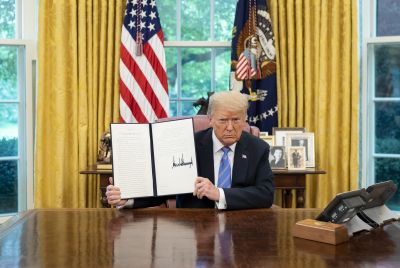Delhi Blast Suspect Photo Circulates: Was the Explosion a Terror Attack? Here's What We Know So Far
Police maintain that the blast bore hallmarks of a planned terror strike.

A day after a car explosion near Delhi's historic Red Fort killed at least 12 people and injured 20 others, the first photograph of the suspected bomber has surfaced. The image, accessed by media, shows Dr Umar Mohammad, a Pulwama-born doctor, who investigators believe was behind Monday evening's blast.
According to reports by NDTV and PTI, Umar Mohammad, born on 24 February 1989 in Jammu and Kashmir's Pulwama, was employed as a doctor at Al-Falah Medical College in Faridabad. He was reportedly associated with a recently uncovered 'white-collar' terror module allegedly linked to Jaish-e-Mohammed.
Police sources cited by multiple outlets said Umar was closely connected with two other doctors, Dr Adeel Ahmad Rather and Dr Mujammil Shakeel, who were arrested in a coordinated operation by police teams from Jammu and Kashmir and Haryana earlier this week. The duo's arrest reportedly led Umar to flee Faridabad before the Delhi explosion occurred.
What the CCTV Footage Shows
CCTV visuals, reviewed by Delhi Police and shared with national media, show a white Hyundai i20 with registration number HR 26CE 7674 entering Delhi through the Badarpur border and later parking near the Red Fort around 3:19 p.m. on Monday.

According to sources, the car remained parked for more than three hours. Investigators said the man inside the vehicle, believed to be Umar, did not step out even once, raising suspicion of a planned detonation. The blast occurred at approximately 6:52 p.m., near the Red Fort Metro Station, setting off a fire that destroyed nearby vehicles and shattered windows in adjacent buildings.
Forensic teams later confirmed the presence of ammonium nitrate at the site, the same chemical seized a day earlier in another neighbouring district of the Indian capital, Faridabad, suggesting a possible link between the two cases, as reported by Indian news agencies.
How the Blast Is Being Investigated
Delhi Police have registered a case under the Unlawful Activities (Prevention) Act (UAPA), treating the incident as a suspected terror attack. While the National Investigation Agency (NIA) is assisting, officials told CNBC-TV18 that it has not yet formally taken over the case.
VIDEO | Delhi: CCTV visuals of the suspect and the car involved in the blast near Red Fort Metro Station, Chandni Chowk.
— Press Trust of India (@PTI_News) November 11, 2025
The blast, which occurred yesterday around 7 PM, claimed at least 9 lives and injured several others.#DelhiBlast #ChandniChowk #SecurityUpdate
(Source -… pic.twitter.com/NatPc37vSa
Investigators are also tracing the ownership of the car, which reportedly changed hands multiple times in the past year. Sources told the media that the car was first sold by a man named Salman to Devender in March 2025, and then to two additional men (who are also being questioned) before ultimately reaching Umar.
Authorities are also probing whether Umar had planned to escape after parking the car, as investigators told ANI that the explosion 'may not have been intended as a suicide attack initially,' but that the situation 'changed unexpectedly.'
Terror Module and the Wider Network
The Delhi explosion has drawn attention to the Faridabad terror module, uncovered just hours before the blast. In coordinated raids across Faridabad, Saharanpur, and Anantnag, police recovered 2,900 kilograms of explosive material, including ammonium nitrate, potassium nitrate, and sulphur. The cache was reportedly linked to a group of doctors accused of sympathising with or supporting extremist organisations.
According to NDTV, the module included several medical professionals, among them, Dr Adeel Ahmad Rather, Dr Muzammil Shakeel, and Dr Shaheen Shahid, who were charged under the Arms Act and UAPA after arms and ammunition were recovered during raids.
Police sources cited by PTI allege Umar Mohammad was part of the same network and that he may have detonated the explosive-laden car after learning about his associates' arrests. Investigators are working to confirm whether the same batch of explosives found in Faridabad was used in the Red Fort blast.
Aftermath and Security Measures
The blast triggered a massive security response across Delhi. According to reports, the Rapid Action Force (RAF) was deployed near the Red Fort. At the same time, the Archaeological Survey of India (ASI) temporarily closed the monument until 13 November as a precautionary measure.
Pained beyond words by the loss of lives in a blast in Delhi. My deepest condolences to those who have lost their loved ones. Have visited the blast site and also met the injured in the hospital. My prayers for their quick recovery.
— Amit Shah (@AmitShah) November 10, 2025
Top agencies are investigating the incident…
Union Home Minister Amit Shah is reportedly reviewing the situation with top security officials, and alerts have been issued across Delhi, Haryana, Uttar Pradesh, Punjab, and several other states, according to government sources.
While police maintain that the blast bore hallmarks of a planned terror strike, final confirmation awaits forensic analysis and DNA results from remains recovered inside the car.
As the investigation deepens, the photograph of the suspect circulating online has become central to the probe.
© Copyright IBTimes 2025. All rights reserved.




















